Magnetic fields are a fascinating subject – they surround us, protect life on earth and allowed orientation, e.g. of migratory birds on far distances and for us humans, long before we relied on smartphones with GPS 😉
We have no sensory organ for magnetic fields, so in physics classes we discuss magnetic fields with the help of their force effects. Iron filings are used to visualize the force field of magnets magnetic, because they form line patterns indicating the magnetic field lines.
This is a very vivid visualisation – but there are several limitations: It is only qualitative (you cannot measure the magnetic flux density by this) and works only on the horizontal plane. Furthermore, what is, for example, “between” the lines that result from the alignment of the iron filings? Should the magnetic field not decrease gradually with distance, instead of significantly staggered?
My friend Finja and I tried several visualization approaches to circumvent these limitations. First, we experimented with ferrofluids (great fun, very messy, still only qualitative) and moved on to use sensors, microcontrollers and some other electronic bits and pieces.
Our first scanner was build from ABS tubes and customized 3d-printed parts we developed on our own. It was supposed to operate with parallel kinematics to have both motors in one place – not to interfere with the measurements taken. We did not get the right bolt drives for it and the strings slipped too much to be precise.
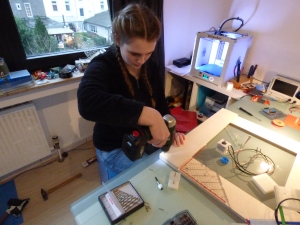 Since the deadline for the science fair was getting close, we chose another path and started all over again. This time we used an old fischertechnik plotter from the 1980’s that has been laying around in our school ever since (unopened!).
Since the deadline for the science fair was getting close, we chose another path and started all over again. This time we used an old fischertechnik plotter from the 1980’s that has been laying around in our school ever since (unopened!).
We exchanged the steel tubes for carbon ones and changed the design a little bit as well. Instead of a pencil it now carries a breakout board for an SMD magnetic sensor, commonly used in robotics to orient the robot according to earth’s magnetic field. It measures the magnetic flux density in 3 dimensions and with 8 different ranges – the HMC588L.
We used a motorshield, added an SD-Card-Shield we built from an Micro-SD-Card Adapter our self, an LCD-Display and Bluetooth to make the device controllable via a Smartphone-App.
We can now analyse the magnetic field by measurement of its flux density and visualize it in 3D. For the moment we only scan regions (a plane) and measure the three-dimensional vector (BX | BY | BZ) | of every single measuring point with assigned coordinates (Y X) automatically.
The result is a vector field – a bit uncommon in 9th class math to 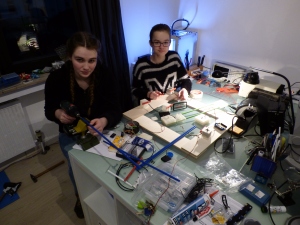 work with 😉
work with 😉
But it is quite easy to understand the principle: If you imagine that the invisible magnetic flux can be measured and the direction of a force resulting from interaction with it would be visualized as an arrow, the direction of the arrow gives you the orientation in space and the length the value or “intensity”. In Physics, you use vectors on an incline to determine the forces acting on an object – and is very obvious that the direction and the value are important!
To imagine a vector field you can simply think of a grainfield, with every grain representing a vector. If no external fource acts upon them, the grains grow more or less identical (same orientation) and reach the same height. External forces can now change the orientation of vectors in this particular field, like a wind blowing over it.
Coming back to magnetic fields, we can determine the spatial orientation and intensity of the magnetic flux at any given point on a 2d plane (scanner area).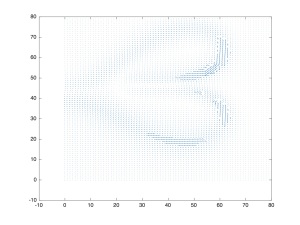
As a result, we have a 5D-vector field of the examined magnets, which can be visualized with the aid of mathematics programs such as Matlab and investigated further.
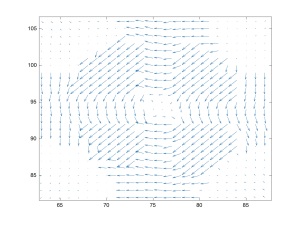 We have some nice examples of current loops and magnets. You can also visualize how the earth’ magnetic field is distorted by even small steel items like a keyhole saw blade.
We have some nice examples of current loops and magnets. You can also visualize how the earth’ magnetic field is distorted by even small steel items like a keyhole saw blade.
For further development we want to extend the scanning device so that the height of the scans can be changed as well – then we would measure a 6D vector field…
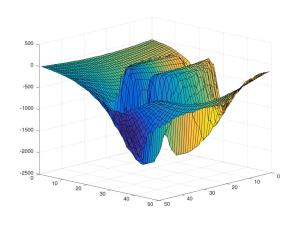 We won first prize in Physics on the federal state level of the science fair Jugend forscht (Schüler experientieren) and a special price for nondestructive examination.
We won first prize in Physics on the federal state level of the science fair Jugend forscht (Schüler experientieren) and a special price for nondestructive examination.
A special thanks to Sebastian Groß from Mathworks – he supported us with the licences of Matlab we needed to visualize and analyse the data!
You can download the PDF here, but it’s in German. We might translate the most interesting parts later on…
MAG3D – Analyse von Magnetfeldlinien als 3D-Vektorfeld
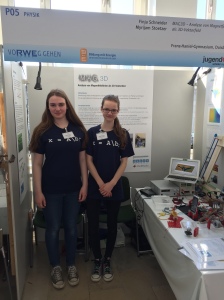
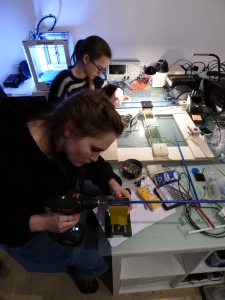
[…] equally nicely in their lab report (PDF, German). You can get a lot of the gist, however, from [Myrijam]’s blog and their Hackaday.io […]
LikeLike
[…] equally nicely in their lab report (PDF, German). You can get a lot of the gist, however, from [Myrijam]’s blog and their Hackaday.io […]
LikeLike
[…] equally nicely in their lab report (PDF, German). You can get a lot of the gist, however, from [Myrijam]’s blog and their Hackaday.io […]
LikeLike
[…] equally nicely in their lab report (PDF, German). You can get a lot of the gist, however, from [Myrijam]’s blog and their Hackaday.io […]
LikeLike
Any progress on the english translation? Nien Sprechen Ze Deutsch!
LikeLike